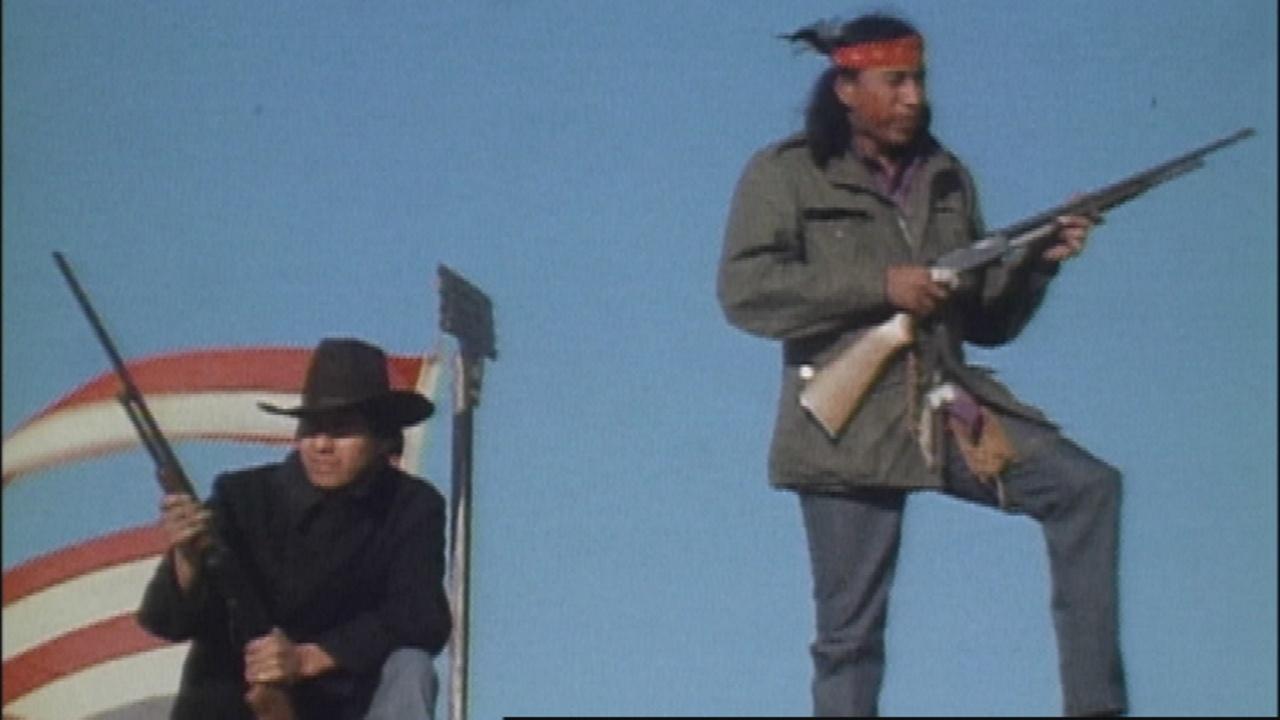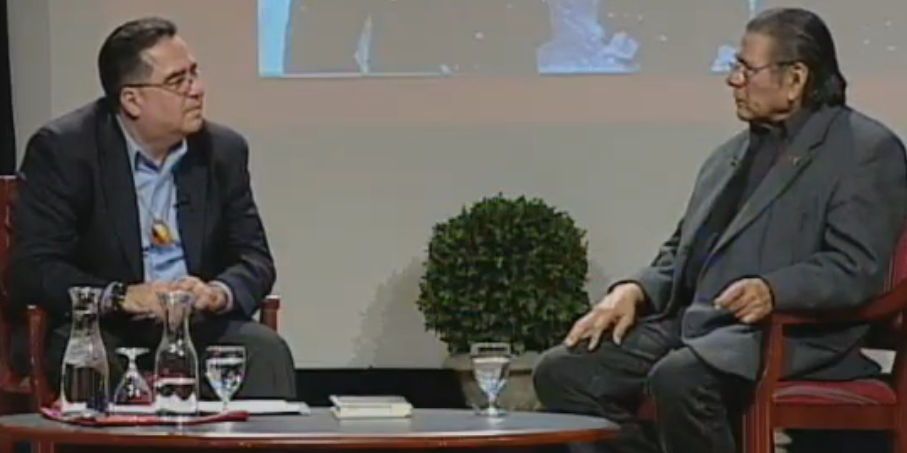
- Details
- By Levi Rickert
Opinion. Monday marks the 50th anniversary of the takeover of Wounded Knee on the Pine Ridge Indian Reservation on February 27, 1973 by the American Indian Movement (AIM).
The siege would last 71 days and would become known as the Wounded Knee II. Some 83 years earlier, on December 29,1890, the U.S. Cavalry Regiment had massacred some 250 innocent Lakota men, women and children on the same land.
The central figures of the 1973 Wounded Knee takeover are now deceased. AIM co-founder Dennis Banks (Leech Lake Ojibwe) died on October 29, 2017; AIM co-founder Clyde Bellecourt (White Earth Nation) died last year on January 11, 2022; and AIM activist Russell Means (Oglala Sioux) died on October 22, 2012.
In 1973, I was still in my youthful days. I was too young to join in the occupation. Years later, my work in Indian Country allowed me to meet and even interview all three of these historic men. I learned a lot about the 1973 Wounded Knee’s history takeover from Banks and Bellecourt.
My friend Paul Collins, who is an internationally acclaimed artist, through a fate of history was in South Dakota painting a series called Other Voices, A Native American Tableau at the time of AIM’s takeover of Wounded Knee.
The previous year, Chief Frank Fools Crow (Lakota), a spiritual leader, was at the United Nations to speak and Collins was there for his Black Portrait of an African Journey exhibition. Fools Crow was so impressed with Collins’ art, he told Collins he should come to South Dakota to paint the Lakota.
Collins met Dennis Banks at Wounded Knee and the two became very close — so much so that they referred to one another as a “brother from another mother.” Because of the close relationship between the two men, Banks would come to Grand Rapids often during the last years of his life. Many times, unexpectedly, Banks would call me to come visit him at Collins’ home. Depending on my schedule, I would take advantage of visiting him and, after founding Native News Online, interviewing Banks.
Even before Native News Online began publishing, I interviewed Banks on stage at Grand Valley State University in Grand Rapids in November 2009 in a program called A Conversation with Dennis Banks. The conversation covered a broad range of topics, and at one point, I asked Banks how AIM ended up at Wounded Knee in 1973.
“First there was a historical significance of Wounded Knee,” Banks told me. “It was the scene of an absolute slaughter where over 250 men, women and children were slaughtered by the U.S. military. And, up until that point, there was never no closure to what happened there.
“So Fools Crow says, ‘Let’s go back to Wounded Knee. Let the spirits help defend us there.’ They were the ones (spiritual leaders) who told us to go there.”
 Dennis Banks, co-founder of the American Indian Movement ,and Levi Rickert at Grand Valley State University for “A Conversation with Dennis Banks” in November 2009. (Photo/Native News Online)
Dennis Banks, co-founder of the American Indian Movement ,and Levi Rickert at Grand Valley State University for “A Conversation with Dennis Banks” in November 2009. (Photo/Native News Online)
Banks further explained that AIM could not take over the village of Pine Ridge because of the strong presence of FBI agents and U.S. Marshals there who were positioned on top of buildings. He said AIM did not want to bring attention to them
He told me that he did not realize how far the U.S. government would go to destroy the American Indian Movement.
What happened at Wounded Knee was nothing short of warfare against Indian warriors. Military helicopters and jets flew overhead. Banks explained at one point there were 35 military tanks there and over 130,000 rounds of ammunition were used against AIM. Most nights were filled with gunfire into the cordoned off town from federal marshals and National Guard members.
With the siege of Wounded Knee, all of the sudden American Indian concerns were front and center in the minds of Americans, who for the most part had thought about American Indians on Thanksgiving. This, of course, was the power of being on nightly newscasts on television. The international media even paid attention to the poor treatment of American Indians.
The American Indian Movement allowed for Americans to get past the Disney version of Indian chiefs galloping through the dusty prairies on horseback wearing long war bonnets. The contemporary warriors—American Indian Movement members—wore blue jeans, cowboy boots, headbands and carried guns.
The longer the siege lasted, the pride in being an American Indian tribal member intensified for many throughout America.
The American Indian Movement leaders became new heroes to a new generation of Native Americans. Average Americans had John Wayne to look up to in movies. In real life, Native Americans had Banks, Bellecourt, Means, and others.
At the end of the 71-siege, two Native Americans were killed and another person remains missing until today.
There is no denying the takeover by AIM of Wounded Knee changed the course of history for Native Americans forever. Later that decade, legislation was enacted in support of Native American rights, including the 1978 American Indian Freedom of Religion Act and the Indian Child Welfare Act.
Fools Crow was right. Maybe there was some closure to what happened to 250 innocent Native Americans in 1890 at Wounded Knee as the result of AIM’s takeover in 1973.
Thayék gde nwéndëmen - We are all related.
More Stories Like This
It is Time for Animal Behavior to Become Its Own DisciplineNative People Recognize ICE Violence. You Should Too.
Building a 21st Century Cherokee Healthcare Workforce
Superhuman. Should We Be Better Than We Are?
Senator Ben Nighthorse Campbell Proved Representation Matters
Help us defend tribal sovereignty.
At Native News Online, our mission is rooted in telling the stories that strengthen sovereignty and uplift Indigenous voices — not just at year’s end, but every single day.
Because of your generosity last year, we were able to keep our reporters on the ground in tribal communities, at national gatherings and in the halls of Congress — covering the issues that matter most to Indian Country: sovereignty, culture, education, health and economic opportunity.
That support sustained us through a tough year in 2025. Now, as we look to the year ahead, we need your help right now to ensure warrior journalism remains strong — reporting that defends tribal sovereignty, amplifies Native truth, and holds power accountable.
 The stakes couldn't be higher. Your support keeps Native voices heard, Native stories told and Native sovereignty defended.
The stakes couldn't be higher. Your support keeps Native voices heard, Native stories told and Native sovereignty defended.
Stand with Warrior Journalism today.
Levi Rickert (Potawatomi), Editor & Publisher


